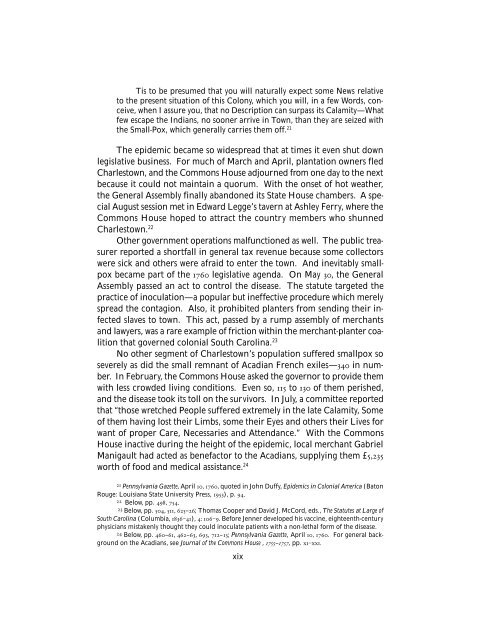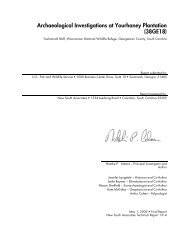The Journal of the Commons House of Assembly
The Journal of the Commons House of Assembly
The Journal of the Commons House of Assembly
Create successful ePaper yourself
Turn your PDF publications into a flip-book with our unique Google optimized e-Paper software.
Tis to be presumed that you will naturally expect some News relativeto <strong>the</strong> present situation <strong>of</strong> this Colony, which you will, in a few Words, conceive,when I assure you, that no Description can surpass its Calamity—Whatfew escape <strong>the</strong> Indians, no sooner arrive in Town, than <strong>the</strong>y are seized with<strong>the</strong> Small-Pox, which generally carries <strong>the</strong>m <strong>of</strong>f. 21<strong>The</strong> epidemic became so widespread that at times it even shut downlegislative business. For much <strong>of</strong> March and April, plantation owners fledCharlestown, and <strong>the</strong> <strong>Commons</strong> <strong>House</strong> adjourned from one day to <strong>the</strong> nextbecause it could not maintain a quorum. With <strong>the</strong> onset <strong>of</strong> hot wea<strong>the</strong>r,<strong>the</strong> General <strong>Assembly</strong> finally abandoned its State <strong>House</strong> chambers. A specialAugust session met in Edward Legge’s tavern at Ashley Ferry, where <strong>the</strong><strong>Commons</strong> <strong>House</strong> hoped to attract <strong>the</strong> country members who shunnedCharlestown. 22O<strong>the</strong>r government operations malfunctioned as well. <strong>The</strong> public treasurerreported a shortfall in general tax revenue because some collectorswere sick and o<strong>the</strong>rs were afraid to enter <strong>the</strong> town. And inevitably smallpoxbecame part <strong>of</strong> <strong>the</strong> 1760 legislative agenda. On May 30, <strong>the</strong> General<strong>Assembly</strong> passed an act to control <strong>the</strong> disease. <strong>The</strong> statute targeted <strong>the</strong>practice <strong>of</strong> inoculation—a popular but ineffective procedure which merelyspread <strong>the</strong> contagion. Also, it prohibited planters from sending <strong>the</strong>ir infectedslaves to town. This act, passed by a rump assembly <strong>of</strong> merchantsand lawyers, was a rare example <strong>of</strong> friction within <strong>the</strong> merchant-planter coalitionthat governed colonial South Carolina. 23No o<strong>the</strong>r segment <strong>of</strong> Charlestown’s population suffered smallpox soseverely as did <strong>the</strong> small remnant <strong>of</strong> Acadian French exiles—340 in number.In February, <strong>the</strong> <strong>Commons</strong> <strong>House</strong> asked <strong>the</strong> governor to provide <strong>the</strong>mwith less crowded living conditions. Even so, 115 to 130 <strong>of</strong> <strong>the</strong>m perished,and <strong>the</strong> disease took its toll on <strong>the</strong> survivors. In July, a committee reportedthat “those wretched People suffered extremely in <strong>the</strong> late Calamity, Some<strong>of</strong> <strong>the</strong>m having lost <strong>the</strong>ir Limbs, some <strong>the</strong>ir Eyes and o<strong>the</strong>rs <strong>the</strong>ir Lives forwant <strong>of</strong> proper Care, Necessaries and Attendance.” With <strong>the</strong> <strong>Commons</strong><strong>House</strong> inactive during <strong>the</strong> height <strong>of</strong> <strong>the</strong> epidemic, local merchant GabrielManigault had acted as benefactor to <strong>the</strong> Acadians, supplying <strong>the</strong>m £5,235worth <strong>of</strong> food and medical assistance. 2421 Pennsylvania Gazette, April 10, 1760, quoted in John Duffy, Epidemics in Colonial America (BatonRouge: Louisiana State University Press, 1953), p. 94.22 Below, pp. 498, 754.23 Below, pp. 504, 511, 625–26; Thomas Cooper and David J. McCord, eds., <strong>The</strong> Statutes at Large <strong>of</strong>South Carolina (Columbia, 1836‒41), 4: 106‒9. Before Jenner developed his vaccine, eighteenth-centuryphysicians mistakenly thought <strong>the</strong>y could inoculate patients with a non-lethal form <strong>of</strong> <strong>the</strong> disease.24 Below, pp. 460–61, 462–63, 693, 712–13; Pennsylvania Gazette, April 10, 1760. For general backgroundon <strong>the</strong> Acadians, see <strong>Journal</strong> <strong>of</strong> <strong>the</strong> <strong>Commons</strong> <strong>House</strong> , 1755–1757, pp. XI‒XXI.xix







